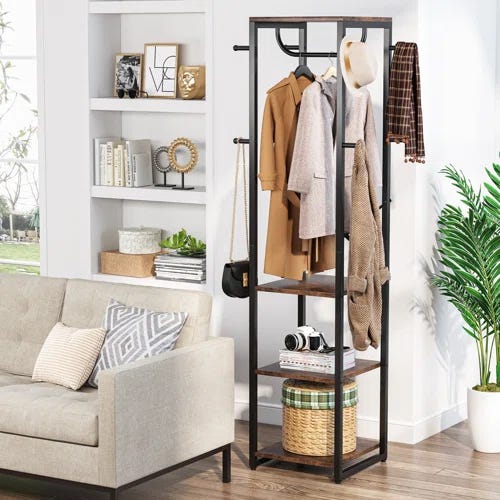For my thoughts are not your thoughts, neither are your ways my ways, declares the Lord. For as the heavens are higher than the earth, so are my ways higher than your ways and my thoughts than your thoughts. Isaiah 55:8-9
I admire the new coat rack my son has put together and arranged on the enclosed porch. On the middle of three shelves he’s placed our mail basket; on the top shelf is a vase with silk flowers.
“Was it hard to put together?” I ask. In addition to the three shelves, there are eight hooks and a bar for hangers. Lacking a downstairs closet, the coat rack can easily hold our winter wraps, coats, and boots. “Were the directions easy to follow?”
“Well,” says my autistic adult son. “ I threw the directions out. It sort of made sense to put it together this way. ”
I nod. Allen is good with tools and can usually figure out how things go together. I place a hand on the middle shelf. “Seems sturdy,” I say. He nods. It is then that I notice two flat metal pieces, about twelve inches long, sticking out from the mail basket. I pick them up. “What are these?”
“Those?” He’s busy packing away his tools and the box the rack came in when he looks up. “I don’t know. They came with the coat rack.”
I hold them up against the rack. Where might they go? I spend a couple of minutes trying to visualize their placement on what looks to me to be a perfectly secure structure.
“Didn’t you think it might need them?” I ask.
“Why? It’s fine, isn’t it?”
“Yes,” I admit. It is fine. I scan the box the pieces came in. It looks like the two flat pieces were to be used as a brace on the sides. I point this out to my son.
He shakes his head and takes the pieces from me. “But if I put them there,” he says, and demonstrates, “you can’t turn the rack around. It has to go in the corner and that hides two of the hooks.”
I realize what he is saying is true. Perhaps the original intent of the design was a corner placement, but Allen has put the rack along the window wall, so three sides are open.
“You’re right,” I say. “It’s better this way.”
He gathers up the boxing materials–including the two unused metal pieces–and carries them out to the trash. Allen has, in effect, reframed the original design for his own purposes.
And isn’t that extraordinary? For years, he avoided the labels of “autism” or “Asperger’s”, but as an adult, he has begun to see the way his brain thinks as part of himself, a strength and not a weakness. In “Reframing Autism”, Lauren Melissa Ellzey talks about how she, as an autistic, needed to reframe her own thinking away from the deficit lens of the American Psychological Association that focused on difficulties and disorders and accept her differences in a positive way. The National Library of Medicine notes that the traditional language used to describe autism is “laden with subjective value judgments” and focuses on negative connotations by classifying autism as a “disorder” not a “difference” (Pediatrics, 2022).
Allen saw the coat rack in a different way. Not worse, not better, just different. It is the way I want others to see him, and the way I want him to see himself.
He comes back in from the trash bin, the two metal strips in his hand.
“I thought you didn’t need them,’ I say.
He shrugs. “Who knows? I might use them for something else. I’ll just have to let my brain think about it for a while. It’ll come up with something.”
I have no doubt that it will.







Such a gentle way of looking at things, Linda. So much to learn. thanks.